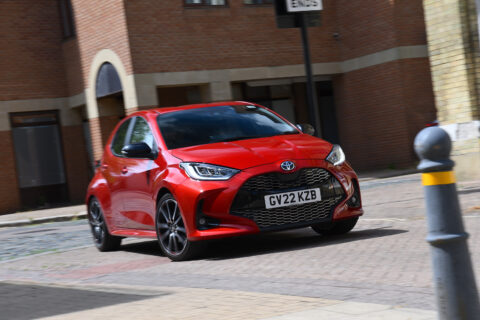
Toyota claims to have improved visibility by setting the instrument panel lower and pulling the A-pillars further back relative to the driver.
We feel the overall efficacy of these measures is marginal where the view forward is concerned, but the Yaris certainly does feel spacious from within – at least for front-seat occupants, who are now set 21mm lower than the previous generation car.
The driver also benefits from adjustment for reach as well as rake in the steering column, so it is easy to find a comfortable and supportive position. The leather-trimmed steering wheel is particularly nice to hold, too, and wouldn’t even feel out of place in, say, the GR Toyota Supra.
In design terms, Toyota has partly reinstated the playful atmosphere the Yaris was once known for – the ‘binocular’ dial arrangement within the instrument binnacle and curvaceous dashboard moulding are two obvious examples – but it has also injected some class into the cabin.
It isn’t difficult to find hard plastics (not least on the cheap-feeling door handles) but interesting fabrics, softer plastics and rubberised surfaces have been deployed among the various surfaces and storage cubbies.
The general curvature of the dashboard and door panels is also pleasing and is a departure from more staid European rivals – the recently rejuvenated French brands notwithstanding. Broadly speaking, perceived quality has also improved, in line with the twelfth-generation Toyota’s larger hatchback, the Toyota Corolla.
Although the Volkswagen Polo and Mini are unlikely to feel too threatened by the Yaris’ style, it will do enough to draw envious glances from drivers of the Ford Fiesta.
But despite all this, and the exterior growth spurt, the Yaris is less impressive in terms of back-seat and luggage space.
The Volkswagen Polo and Renault Clio do notably better in both areas and in objective terms, and the Yaris actually has a marginally less roomy boot than its predecessor.
Toyota does at least fit a variable-height boot floor, which is useful on those occasions when maximum capaciousness isn’t required and the size of the loading lip can be reduced.
Toyota Yaris infotainment and sat-nav
The Yaris launched with the Toyota Touch 2, the brand’s touchscreen infotainment system, but the size of the screen differs depending on which specification level you choose.
Cars with the Icon trim made use of a more dated 7.0in display, while the rest of the Yaris line-up benefits from an 8.0in touchscreen, excluding the top-of-the-range Excel model, which gets a bigger 9.0in system.
Perhaps the most important thing you need to know about the infotainment system in the Yaris is that both Apple CarPlay and Android Auto smartphone integration come as standard.
And, frankly, owners are likely to rely on those applications heavily, not only because there exists no navigation provision with the basic system but also because Toyota’s system of menus can be awkward to use, with small graphics and some latency.
Certainly, alternatives such as the systems fitted in the Mini and Volkswagen Polo are considerably slicker. There are also USB ports and, on UK cars, standard-fit reversing cameras, albeit of low resolution.
In terms of hardware, the entry-level Yaris Icon uses a central 7.0in touchscreen, although our Design test car benefits from an 8.0in display. There are also USB ports and, on UK cars, standard-fit reversing cameras, albeit of low resolution.
In 2024, all Yaris models will receive an upgrade in this respect, gaining a much more modern 9.5in touchscreen with crisper graphics and smoother operation. The highest trim levels will get a 10.5in display.
